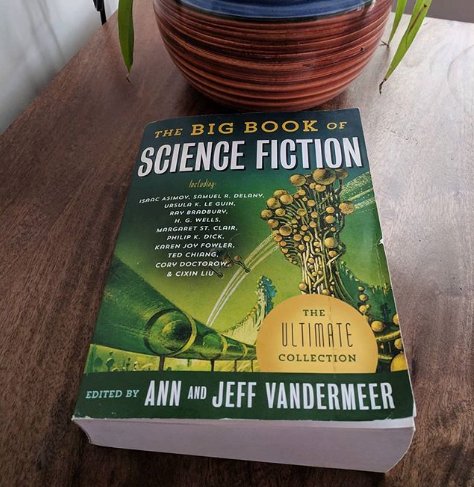Ann and Jeff VanderMeer
If science fiction is even remotely of interest to you, this is a veritable treasure trove! 105 stories spanning 1160 pages. Only a couple of authors get to have more than one story, and that means there is a diversity of work that’s arguably unparalleled in any collection of this nature. The stated objective of the book is indeed that – diversity. And it happens on multiple counts – non-English writings (and therefore, the variety of geographical settings – other than Antarctica, all continents are represented), gender (of authors and characters), and most importantly, the type of science fiction – dystopian, alien encounters, space operas, post-apocalypse, and even satire.
The stories are broadly in a chronological order of when they were written. The introduction to each author before the beginning of a story is very helpful in terms of context setting.
While I do love science fiction, I really haven’t read enough to comment on the choices of representation made by the authors. I can count on one hand the number of stories I have previously read. But at least a couple of them are my all-time favourites in fiction – Asimov’s “The Last Question” and Ted Chiang’s “Story of your life”. I also found a story – Sandkings -by an author familiar to many of us from an alternate “universe” – George R.R. Martin. An absolute thriller that I thoroughly enjoyed.
My other favourites are these : The Triumph of Mechanics by Karl Hans Strobl, a macabre, dystopian tale with a sense of humour! Desertion by Clifford D. Simak, a story based on pantropy – modifying humans for space exploration, as opposed to changing the alien environment. Another favourite that uses this theme is Surface Tension by James Blish. Philip K. Dick’s Beyond Lies the Wub seems quite prescient about “we are what we eat”! Katherine Maclean’s The Snowball Effect is about an experiment by academia in a sociological setting that leads to a more-than-anticipated impact. William Tenn’s Liberation of Earth is a brilliant commentary on US intervention in Korea/Vietnam, even while doing a great job of reducing the collective ego of the apex species of earth! His other work The Ghost Standard, later in the book, is an absolutely delightful satire.
Grandpa, by James H. Schmitz has alien ecology as a theme and builds the tension excruciatingly well! Stranger Station by Damon Knight is an intense first-alien-contact story that dwells on the complexities very well. Vadim Shefner’s A Modest Genius is a lovely tale of romance and invention while Sever Gansovsky’s Day of Wrath is a thriller based on biotech experimentation gone wrong. The Hands by John Baxter is a creepy tale that reminded me of Aliens.
F.L. Wallace’s Student Body would make it to my top 5 in the book, exploring both alien contact and environmental impact really well. The feminist utopian world created by Joanna Russ in When it Changed is subtle yet impactful. Yasutaka Tsustsui’s Standing Woman is as poignant as it is surreal. Sporting with the Chid by Barrington J. Bayley is dark and builds up to a terrifying climax.
Josephine Saxton’s The Snake Who Read Chomsky is another incisive tale on biotech experimentation with some excellent twists and turns. Reiko’s Universe Box by Kajio Shinji is somehow sad and upbeat at the same time. Greg Bear’s Blood Music combines microscopic phenomena and macroscopic impact really well. Robert Reed’s The Remoras uses a space opera setting for an excellent human drama. The last story in the book – Baby Doll by Johanna Sinisalo – is a disturbing take on sexualisation of children that falls well within the realms of possibility, sadly.
Isaac Asimov, Ursula K. Le Guin, Ray Bradbury, H.G. Wells – the book has work by all the greats of the genre, and you are also likely to discover authors whose stories you will enjoy!


Leave a Reply